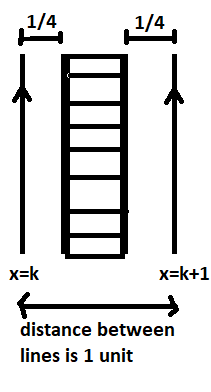
A coin of diameter $\dfrac{1}{2}$ units is tossed randomly onto the rectangular cartesian plane, the probability that the coin does not intersect any line whose equation is of the form \[x = k\] , is
A.$\dfrac{1}{{\sqrt 2 }}$
B.$1 - \dfrac{1}{{\sqrt 5 }}$
C.$\dfrac{1}{4}$
D.$\dfrac{1}{2}$
Answer
574.5k+ views
Hint: Here we use the concept of probability and x-y plane.
Required Formula: ${\text{Probability of an event = }}\dfrac{{{\text{favourable cases}}}}{{{\text{Total cases}}}}$
Complete step by Solution:
Given: Diameter of a coin tossed is $\dfrac{1}{2}$ $ \Rightarrow radius = \dfrac{{diameter}}{2} = \dfrac{1}{4}$
Equation of the line is \[x = k\].
Consider two adjacent lines \[x = k{\text{ }}and\;x = k + 1\]
We need line equations of the form \[x = k{\text{ }}and\;x = k + 1\].
According to the question, For the favorable event, the centre of the coin should fall into a shaded region.

Distance between two adjacent lines \[x = k{\text{ }}and\;x = k + 1\] is $1$.
As radius is $\dfrac{1}{4}$ from both adjacent lines, If the coin falls exactly in the shaded region it will not intersect the two lines.
\[ \Rightarrow {\text{Required probability = }}\dfrac{{{\text{Area of shaded portion}}}}{{{\text{Distance between two adjacent lines}}}}{\text{ = }}\dfrac{{\dfrac{{\text{1}}}{2}}}{1}{\text{ = }}\dfrac{{\text{1}}}{2}\]
Hence, Option choice D is the correct answer.
Note: In such types of questions which involves concept probability having an idea about the formula is needed. Sometimes probability questions may be accompanied with x-y planes. Graphing helps to solve the question. Follow the conditions in the question. Frame the equations accordingly to get the required value.
Required Formula: ${\text{Probability of an event = }}\dfrac{{{\text{favourable cases}}}}{{{\text{Total cases}}}}$
Complete step by Solution:
Given: Diameter of a coin tossed is $\dfrac{1}{2}$ $ \Rightarrow radius = \dfrac{{diameter}}{2} = \dfrac{1}{4}$
Equation of the line is \[x = k\].
Consider two adjacent lines \[x = k{\text{ }}and\;x = k + 1\]
We need line equations of the form \[x = k{\text{ }}and\;x = k + 1\].
According to the question, For the favorable event, the centre of the coin should fall into a shaded region.

Distance between two adjacent lines \[x = k{\text{ }}and\;x = k + 1\] is $1$.
As radius is $\dfrac{1}{4}$ from both adjacent lines, If the coin falls exactly in the shaded region it will not intersect the two lines.
\[ \Rightarrow {\text{Required probability = }}\dfrac{{{\text{Area of shaded portion}}}}{{{\text{Distance between two adjacent lines}}}}{\text{ = }}\dfrac{{\dfrac{{\text{1}}}{2}}}{1}{\text{ = }}\dfrac{{\text{1}}}{2}\]
Hence, Option choice D is the correct answer.
Note: In such types of questions which involves concept probability having an idea about the formula is needed. Sometimes probability questions may be accompanied with x-y planes. Graphing helps to solve the question. Follow the conditions in the question. Frame the equations accordingly to get the required value.
Recently Updated Pages
Two men on either side of the cliff 90m height observe class 10 maths CBSE

What happens to glucose which enters nephron along class 10 biology CBSE

Cutting of the Chinese melon means A The business and class 10 social science CBSE

Write a dialogue with at least ten utterances between class 10 english CBSE

Show an aquatic food chain using the following organisms class 10 biology CBSE

A circle is inscribed in an equilateral triangle and class 10 maths CBSE

Trending doubts
Why is there a time difference of about 5 hours between class 10 social science CBSE

Write a letter to the principal requesting him to grant class 10 english CBSE

What is the median of the first 10 natural numbers class 10 maths CBSE

The Equation xxx + 2 is Satisfied when x is Equal to Class 10 Maths

Which of the following does not have a fundamental class 10 physics CBSE

State and prove converse of BPT Basic Proportionality class 10 maths CBSE




